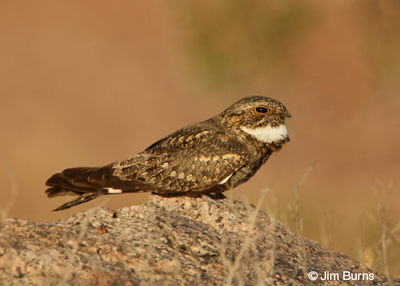
The right place is anyplace such as an athletic field, freeway ramp, or parking lot with tall floodlights or security beams. The right time is shortly after dusk during spring or fall migration. The best way to distinguish between the two species is the shape and placement of the white wing patch, straighter and closer to the wingtip in Lesser than in Common. Given the gloaming and their erratic flight pattern though, positive identification at night is problematical.
Nighthawks are not, of course, true hawks in the raptorial sense but this, their most commonly used name, comes from the fact that they feed at night, and “hawk,” as a verb derived from the old Anglo-Saxon word hafoc, meaning “seize,” for insects on the wing. For a full discussion of this fascinating family and the derivation of their other common names, see jimburnsphotos.com/pages/4-6-07.html.
The noteworthy aspect of my workplace sighting last month was the date, November 16, which is later by ten days than my prior fall late date, and it is not such a small sample size as you might suspect, given I am going on thirty-one years at this location. Is this another avian sign of global warming? Could be. Or is it simply because of a better monsoon season and above average autumn precipitation which has resulted in a larger insect biomass this year? Could be, but actually now that I’m into moth photography, I’ve noted a lot less insect activity around the lights this year than last.
Only twice in all my years here have I observed nighthawks around the lights in June through August. I’ve always assumed these fall feeding congregations are Lesser Nighthawks, a species that breeds throughout the desert Southwest and Mexico and spends winter in southern Mexico and Central America. Common Nighthawks, which breed throughout North America and migrate to South America, one of the longest migration journeys of any of our birds, are known to leave earlier in the fall because they have farther to go.
Regardless of positive identification or indications of planetary environmental issues, it is always fun to point the nighthawks out to non-birding clients. How many birds are out and about after dark, and how many families of birds have such a fascinating history steeped in folklore dating to our species’ earliest observations of the world around us. Man and nighthawks have evolved, grown up if you will, together. Somewhat mysterious, like our owls, nighthawks remind us there is still much to learn about the natural world around us.